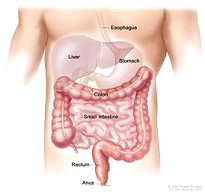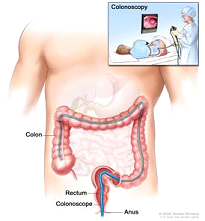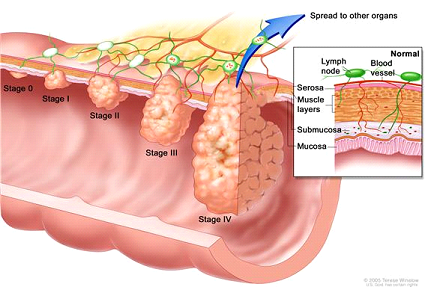Rectal Cancer
Rectal Cancer
-
Rectal cancer is a disease in which malignant (cancer) cells form in the tissues of the rectum.
The rectum is part of the body’s digestive system. The digestive system removes and processes nutrients (vitamins, minerals, carbohydrates, fats, proteins, and water) from foods and helps pass waste material out of the body. The digestive system is made up of the esophagus, stomach, and the small and large intestines. The first 6 feet of the large intestine are called the large bowel or colon. The last 6 inches are the rectum and the anal canal. The anal canal ends at the anus (the opening of the large intestine to the outside of the body).

Signs and symptoms
-
These and other symptoms may be caused by rectal cancer. Other conditions may cause the same symptoms. A doctor should be consulted if any of the following problems occur:
A change in bowel habits.
> Diarrhea.
> Constipation.
> Feeling that the bowel does not empty completely.Stools that are narrower or have a different shape than usual.
> Blood (either bright red or very dark) in the stool.
> General abdominal discomfort (frequent gas pains, bloating, fullness, or cramps).
> Change in appetite.
> Weight loss for no known reason.
> Feeling very tired.
Diagnosis
-
Tests used to diagnose rectal cancer include the following:
> Physical exam and history: An exam of the body to check general signs of health, including checking for signs of disease, such as lumps or anything else that seems unusual. A history of the patient’s health habits and past illnesses and treatments will also be taken.
> Digital rectal exam (DRE): An exam of the rectum. The doctor or nurse inserts a lubricated, gloved finger into the lower part of the rectum to feel for lumps or anything else that seems unusual. In women, the vagina may also be examined.
> Proctoscopy: An exam of the rectum using a proctoscope, inserted into the rectum. A proctoscope is a thin, tube-like instrument with a light and a lens for viewing. It may also have a tool to remove tissue to be checked under a microscope for signs of disease.
> Colonoscopy: A procedure to look inside the rectum and colon for polyps (small pieces of bulging tissue), abnormal areas, or cancer. A colonoscope is a thin, tube-like instrument with a light and a lens for viewing. It may also have a tool to remove polyps or tissue samples, which are checked under a microscope for signs of cancer.

> Biopsy: The removal of cells or tissues so they can be viewed under a microscope to check for signs of cancer. Tumor tissue that is removed during the biopsy may be checked to see if the patient is likely to have the gene mutation that causes HNPCC. This may help to plan treatment.
Staging
-
Stage 0 (Carcinoma in Situ)
In stage 0, abnormal cells are found in the innermost lining of the rectum. These abnormal cells may become cancer and spread into nearby normal tissue. Stage 0 is also called carcinoma in situ.
-
Stage I
In stage I, cancer has formed and spread beyond the innermost lining of the rectum to the second and third layers and involves the inside wall of the rectum, but it has not spread to the outer wall of the rectum or outside the rectum. Stage I rectal cancer is sometimes called Dukes A rectal cancer.
-
Stage II
In stage II, cancer has spread outside the rectum to nearby tissue, but it has not gone into the lymph nodes (small, bean-shaped structures found throughout the body that filter substances in a fluid called lymph and help fight infection and disease). Stage II rectal cancer is sometimes called Dukes B rectal cancer.
-
Stage III
In stage III, cancer has spread to nearby lymph nodes, but it has not spread to other parts of the body. Stage III rectal cancer is sometimes called Dukes C rectal cancer.
-
Stage IV
In stage IV, cancer has spread to other parts of the body, such as the liver, lungs, or ovaries. Stage IV rectal cancer is sometimes called Dukes D rectal cancer.
-
Recurrent Rectal Cancer
Recurrent rectal cancer is cancer that has recurred (come back) after it has been treated. The cancer may come back in the rectum or in other parts of the body, such as the colon, pelvis, liver, or lungs.

Treatment
-
Surgery
Surgery is the most common treatment for all stages of rectal cancer. The cancer is removed using one of the following types of surgery:> Polypectomy: If the cancer is found in a polyp (a small piece of bulging tissue), the polyp is often removed during a colonoscopy.
>Local excision: If the cancer is found on the inside surface of the rectum and has not spread into the wall of the rectum, the cancer and a small amount of surrounding healthy tissue is removed.
>Resection: If the cancer has spread into the wall of the rectum, the section of the rectum with cancer and nearby healthy tissue is removed. Sometimes the tissue between the rectum and the abdominal wall is also removed. The lymph nodes near the rectum are removed and checked under a microscope for signs of cancer.
>Pelvic exenteration: If the cancer has spread to other organs near the rectum, the lower colon, rectum, and bladder are removed. In women, the cervix, vagina, ovaries, and nearby lymph nodes may be removed. In men, the prostate may be removed. Artificial openings (stoma) are made for urine and stool to flow from the body to a collection bag. -
Targeted therapy
Targeted therapy is a type of treatment that uses drugs or other substances to identify and attack specific cancer cells without harming normal cells. Monoclonal antibody therapy is a type of targeted therapy being studied in the treatment of rectal cancer.
Monoclonal antibody therapy uses antibodies made in the laboratory from a single type of immune system cell. These antibodies can identify substances on cancer cells or normal substances that may help cancer cells grow. The antibodies attach to the substances and kill the cancer cells, block their growth, or keep them from spreading. Monoclonal antibodies are given by infusion. They may be used alone or to carry drugs, toxins, or radioactive material directly to cancer cells. -
Radiation therapy
Radiation therapy is a cancer treatment that uses high-energy x-rays or other types of radiation to kill cancer cells or keep them from growing. There are two types of radiation therapy. External radiation therapy uses a machine outside the body to send radiation toward the cancer. Internal radiation therapy uses a radioactive substance sealed in needles, seeds, wires, or catheters that are placed directly into or near the cancer. The way the radiation therapy is given depends on the type and stage of the cancer being treated. -
Chemotherapy
Chemotherapy is a cancer treatment that uses drugs to stop the growth of cancer cells, either by killing the cells or by stopping them from dividing. When chemotherapy is taken by mouth or injected into a vein or muscle, the drugs enter the bloodstream and can reach cancer cells throughout the body (systemic chemotherapy). When chemotherapy is placed directly into the spinal column, an organ, or a body cavity such as the abdomen, the drugs mainly affect cancer cells in those areas (regional chemotherapy). Bladder cancer may be treated with intravesical (into the bladder through a tube inserted into the urethra) chemotherapy. The way the chemotherapy is given depends on the type and stage of the cancer being treated.
 Emergency Help line
Emergency Help line 
